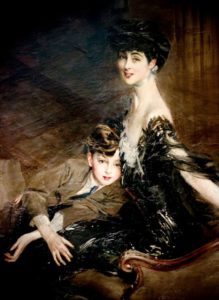
Consuelo Vanderbilt and her son by Giovanni Boldini, 1906
In 1903, the willowy Consuelo Vanderbilt was the reigning society beauty. Houdini was escaping from seemingly impossible extrications. Sherlock Holmes had newspaper readers in thrall. It was also the year that French pharmacist and perfumer Joseph Lesquendieu launched his line of high-quality perfumes and beauty products, his brand becoming well-known by the 1920s. Now, after a dormancy of nearly 30 years, J. Lesquendieu has returned. With their flapper charm and society dame shimmer, the reissued fragrances are set to make their mark on the twenty-first century
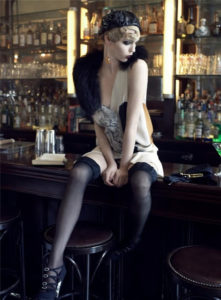 .
.
1920s fashion editorial, photo by Stephen Meisel for Vogue, Sept 2007
After M. Lesquendieu died in 1962, the line apparently withered, finally ceasing production in the early eighties. Happily, however, in 2015 one of Lesquendieu’s grandsons resurrected the line and brought back three of the house’s signatures: Bonne Fortune, Feu de Bengale (both 1953), a gingery citrus and fruity floral, respectively; and the resinous oriental Glorilis (1925) and also introduced two new fragrances Lesquendieu le Parfum, a racy tea scent, and Lilice, a powdery floral. The new line has been issued in extrait only, which give them a roundedness and depth. The richness and quality of ingredients smells first-rate and reaches back to a time when perfumers did not cut corners to produce extravagant creations like Caron Acaciosa and Guerlain Shalimar. All five fragrances share a timeless kinship: if you were to smell them blind, you might mistake grey iris Lilice for a vintage perfume, while the saturated, woody resins of Glorilis feel contemporary and modish. They are each well-constructed and quite lovely, but the standouts for me are Lesquendieu le Parfum and Glorilis.
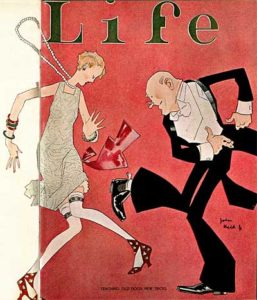
Cover of Life Magazine showing the Charleston, 1926
Lesquendieu le Parfum may be a modern creation, but she could easily be a Charleston-hopping flapper. Her entrance is arresting: a sharp tang of bergamot practically jumps off the skin. The zing of the bitter orange strikes a pose for a few moments, standing in relief from the purring, vaporous ginger warming up in the background. Then, the tempo changes, and a narcotic, sleepy sweetness of jasmine unfurls while the ginger blankets the citrus, and Lesquendieu turns languorous.
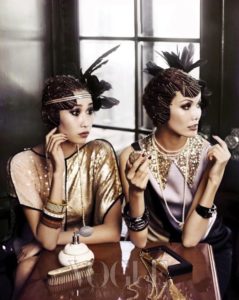
Roaring Twenties fashion editorial, photo by Bohnchang Koo, Vogue Korea, October 2013
A tea note with the smoky, floral astringency of lapsang souchong seems to rise like steam through the perfume’s center, and the aromas of jasmine, ginger, tea and bitter orange dance around each other like a tango; bergamot dominating one moment, ginger the next, tea a moment thereafter. Just as the party seems to be dispersing, labdanum shimmies her way into room, adding a welcome ouch of raunchiness and keeping the heat going well into the dry down. The overall effect is spicier and drier than L’Artisan’s Tea for Two and drier, less bready than Serge Lutens’ Five O’Clock Gingembre, which traverse the same ground.
Lesquendieu le Parfum notes: Bergamot, Tea, Birch, Jasmine, Tonka bean, Labdanum, Amber, Cedar, Vanilla. Sillage is moderate and longevity about 4-6 hours.
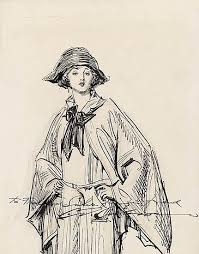
Untitled, Charles Dana Gibson, c. 1920
If Lesquendieu le Parfum recalls a page-boy flapper, Glorilis, an incense-y, woody oriental, is a Gibson Girl in an oriental parlor: luxuriant, polished, poised. It was created in 1925 but its tricksy use of woods, resin and spice notes feels effortlessly modern. This is one of those rare beauties you dab on and immediately feel expensive. A billow of anisic incense and a crackle of black pepper opens Glorilis, skirting a line between spice and smokiness. As the fragrance warms, vanillic woods follow before the whole composition starts getting earthy with a particularly hefty labdanum. On the skin, Glorilis is warm, enveloping and sensual.
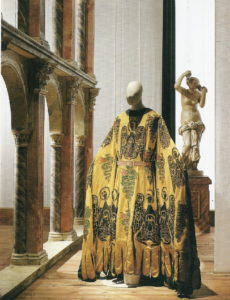
Vintage Fortuny dress at Fortuny y Madrazo: An Artistic Legacy exhibition, Queen Sofia Institute.
The way the notes are woven in Glorilis creates a trompe l’oeil effect: although benzoin is not listed, the vanilla, incense and labdanum intertwine in such a way as to create a sensation of that semisweet, glowing resin. And while there is no ginger, either, there is an impression oftickly spice that keeps tricking me into detecting its presence, which may well be the geranium. Glorilis’ dry down is like thick silk: syrupy woods, like aged sherry casks, combine with the heated clove spice of carnation and an amalgam of resinous spice. A delicious, rich, sophisticated cold weather scent, Glorilis is glorious.
Glorilis notes: Bergamot, Black Pepper, Carnation, Rose, Labdanum, Geranium, Vetiver, Vanilla, Cedar, Incense. Sillage is moderate and longevity is good – about 6 hours.
Disclaimer: I received my samples from Twisted Lily – many thanks. My opinions are my own.
— Lauryn Beer. Editor
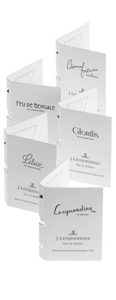
Thanks to the generosity of Twisted Lily, we have samples for a registered reader in the U.S. To be eligible please leave a comment with what appeals to you about Lesquendieu le Parfum or Glorilis based on Lauryn’s review, which you would like to winand if you have a favorite Roaring Twenties Perfume. Draw closes 12/20/16.
We announce the winners only on site and on our Facebook page, so Like Cafleurebon and use our RSS option…or your dream prize will be just spilled perfume
